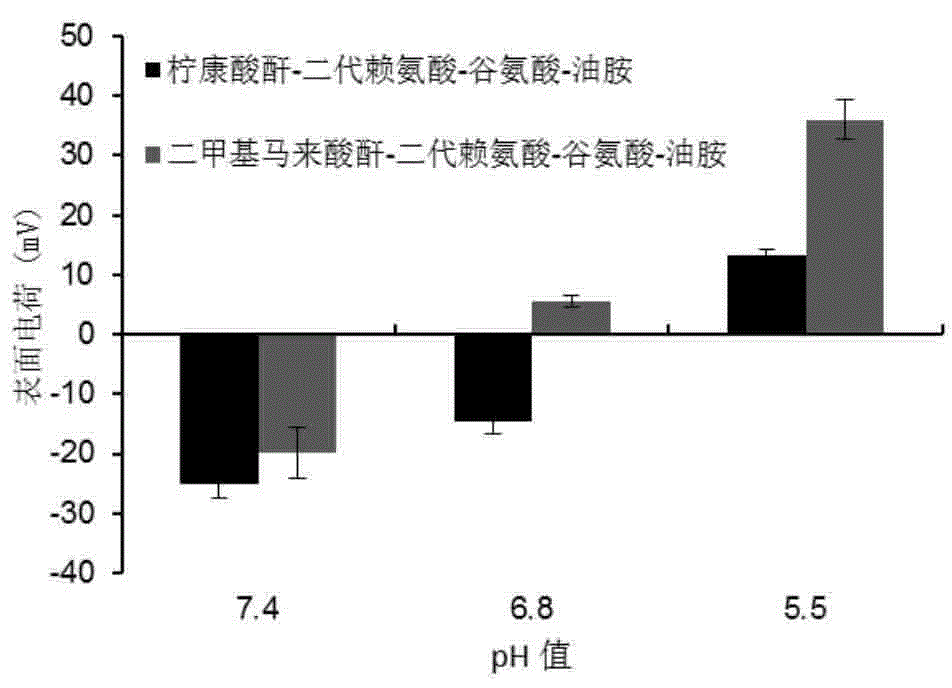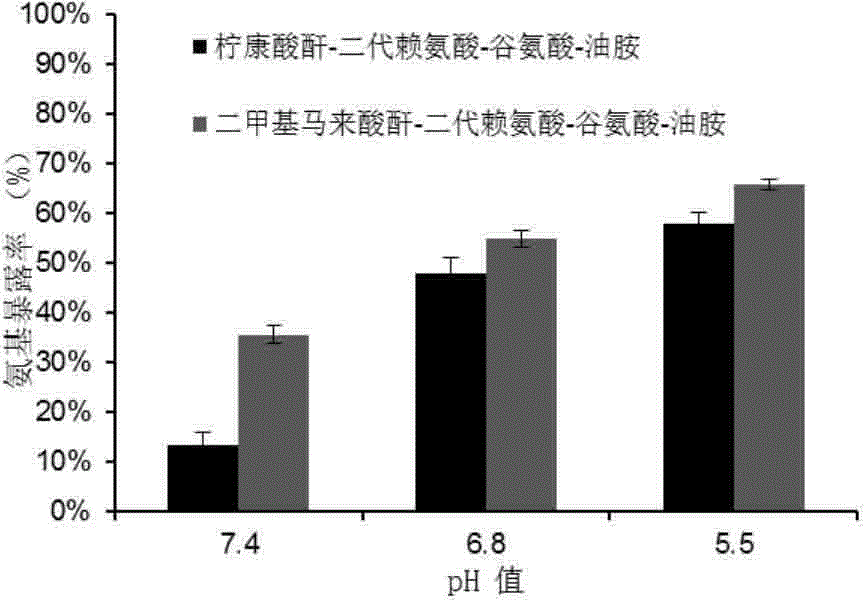PH response type lipid based on dendrimers as well as preparation method and application of pH response type lipid
A dendrimer and responsive technology, applied in the field of biomedical materials, can solve the problem that non-viral vectors are difficult to obtain high transfection efficiency in vivo and in vitro
- Summary
- Abstract
- Description
- Claims
- Application Information
AI Technical Summary
Problems solved by technology
Method used
Image
Examples
Embodiment 1
[0063] (1) Adopt divergence method or convergence method or the method that divergence-convergence combines to synthesize dendrimers of more than two generations (can refer to the method described in the patent literature of CN 103554923A), also can adopt commercially available dendrimers molecular;
[0064] (2) Carry out end group modification on the periphery of the dendritic molecule, and graft a large number of amino groups and / or guanidine groups on the periphery. When lysine or arginine or histidine is selected as the repeating unit of the dendrimer, the above-mentioned end group modification step is not required;
[0065] (3) Protect the peripheral functional groups of the resulting dendrimers containing amino groups and / or guanidine groups, and only expose one or two functional groups at one end, and then connect one end of the dendrimers through the exposed functional groups branched hydrophobic groups;
[0066](4) Removing the protecting group of amino group and / or...
Embodiment 2
[0072] (1) Dissolve plasmid DNA or RNA in sterile HBG buffer solution (20 mmoles of 4-hydroxyethylpiperazineethanesulfonic acid, 5% glucose) to prepare a 0.1 mg / mL gene solution; Dissolve in HBG buffer solution, and prepare solution A of 0.1-10 mg / mL; add any pH-responsive lipid material prepared in Example 1 into HBG buffer solution, and prepare solution A of 0.1-10 mg / mL B; or add the two pH-responsive lipid materials containing A-type groups and B-type groups prepared in Example 1 respectively into the HBG buffer solution by ethanol injection, and prepare a solution of 0.1-10 mg / mL B and C.
[0073] (2) Mix the solution A obtained in the above steps with the gene solution, and incubate at room temperature for 20 minutes to obtain a binary complex, then add solution B or solutions B and C in proportion, and incubate at room temperature for 20 minutes After that, a ternary complex is obtained.
[0074] Optionally, the cationic carrier is a cationic lipid or a commercially a...
Embodiment 3
[0079] Embodiment 3: citraconic anhydride-second-generation lysine-glutamic acid-n-undecylamine (CIT-Lys(G2)-Glu-UA 2 ,CLG2C 11 ) preparation
[0080] Take the fan-shaped dendrimers (protected by the second-generation amino Pbf / Boc) of lysine as the repeating unit of the 1st generation and the 2nd generation, glutamic acid-n-undecylamine, condensing agent (such as: 1-ethyl-(3- Dimethylaminopropyl) carbodiimide hydrochloride EDC, catalyst 1-hydroxybenzotriazole (HOBt), base (N, N-diisopropylethylamine DIPEA) according to 1:1:2: The molar ratio of 2:4, at 0 ℃, under the condition of nitrogen protection, add dichloromethane solvent, react for 0.5 hours; then react at room temperature for 24 hours, after the reaction is completed, the obtained solution is sequentially washed with sodium bicarbonate solution, sodium bisulfate solution and Wash with aqueous sodium chloride, dry over anhydrous magnesium sulfate for 12 hours, concentrate under reduced pressure, use ethyl acetate:pet...
PUM
| Property | Measurement | Unit |
|---|---|---|
| Carrier particle size | aaaaa | aaaaa |
Abstract
Description
Claims
Application Information
 Login to View More
Login to View More - R&D
- Intellectual Property
- Life Sciences
- Materials
- Tech Scout
- Unparalleled Data Quality
- Higher Quality Content
- 60% Fewer Hallucinations
Browse by: Latest US Patents, China's latest patents, Technical Efficacy Thesaurus, Application Domain, Technology Topic, Popular Technical Reports.
© 2025 PatSnap. All rights reserved.Legal|Privacy policy|Modern Slavery Act Transparency Statement|Sitemap|About US| Contact US: help@patsnap.com



